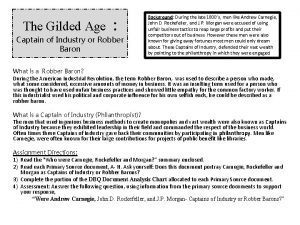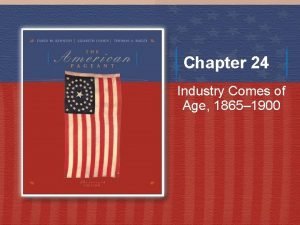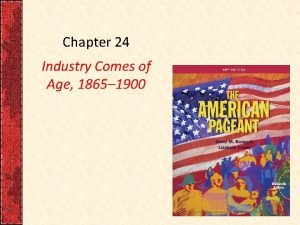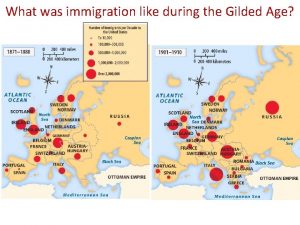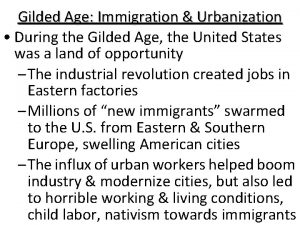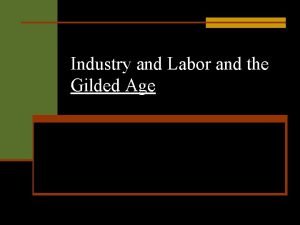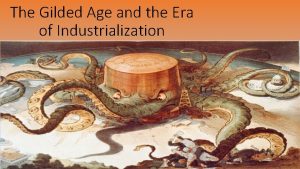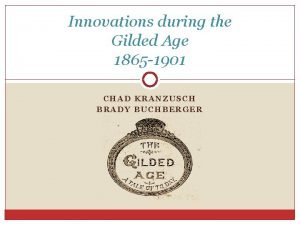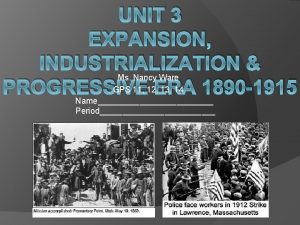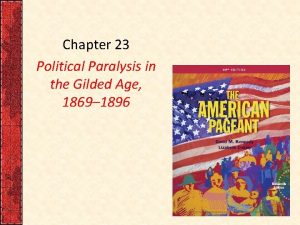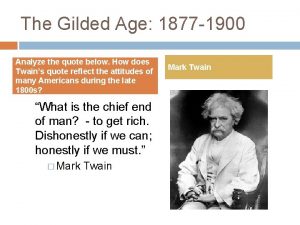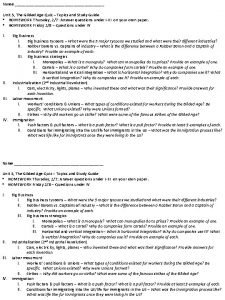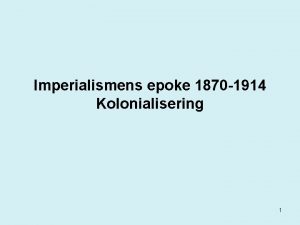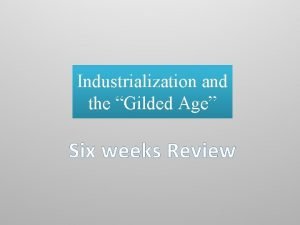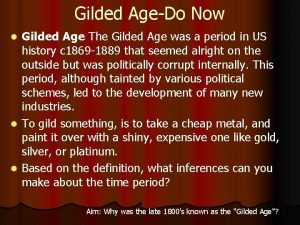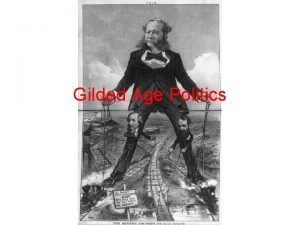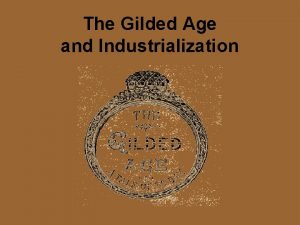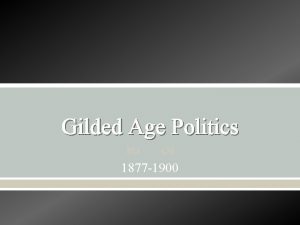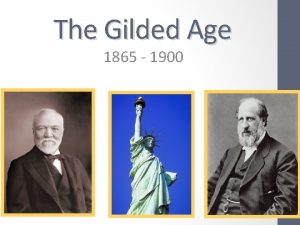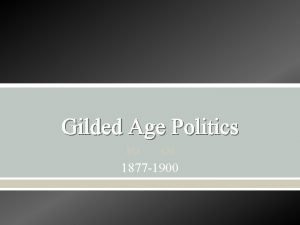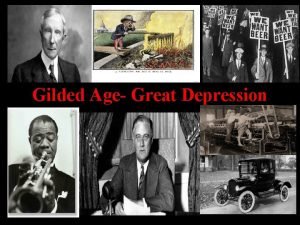Ch 24 Industry Comes of Age Gilded Age


























- Slides: 26

Ch. 24 – Industry Comes of Age

Gilded Age Industrialization ■ During the Gilded Age, American businesses were transformed: –Massive corporations replaced small, family businesses –New technology, transportation, marketing, labor relations, & efficient mass-production –By 1900, the U. S. was the most industrialized country in the world

The Business of Invention ■ 19 th-century inventors led to an “Age of Invention”: – Cyrus Field’s telegraph cable By – 1905, 10 million Americans cash had phones; Business typewriters, (Bell Telephone Co became AT&T) registers, adding machines – High-speed textile spindles, auto looms, sewing machines – George Eastman’s Kodak camera – Alexander G. Bell’s telephone

The Business of Invention ■ Thomas Edison, the “Wizard of Menlo Park, ” created the 1 st research lab in New York –Edison Illuminating Co was the to 1 st use electric light in 1882 –Tesla’s alternating current (AC) allowed electricity to travel over longer distances & to power streetcars & factories

The Business of Invention ■ New technologies allowed for increased industrial production –New machines were incorporated into the first assembly lines which allowed for continuous & faster production of goods –The railroad linked every region of America & allowed for a mass consumption of goods

Chicago Meatpackers: The 1 st “Disassembly Line”

A new-and-improved revolution” : The Midwest Made“market Meat for America More regional specialization made mass production & mass consumption possible

New Methods of Marketing ■ Marketing became a “science”: –Advertising firms boomed –Department stores like Macy’s & Marshall Field’s allowed customers to browse & buy –Chain stores like A&P Grocery & Woolworth’s “Five & Ten” –Mail-order catalogues, like Montgomery Ward sold to all parts of America

New Forms of Business Organization “Trusts” use a board “Holding companies” ■of. New types trustees to of business oversee & organization manage other were used to increase manage a company subsidiaryprofits: companies –“Trusts” & “holding companies” integrated various businesses under 1 board of directors –Vertical & horizontal integration maximized corporate profits –Frederick Taylor’s “scientific management” emphasized time efficiency & mid-level managers

Vertical Horizontal. Mergers Integration U. S. &Corporate By 1900, 1% of U. S. companies controlled 33% of all industry

New Forms of Business Organization ■ Business leaders used a variety of ideas to justify their wealth: –The “Gospel of Wealth” Wealth argued that it is God's will that some men attained great wealth –Social Darwinism taught that natural competition weeds out the weak & the strong survive –Were monopolists “captains of industry” or “robber barons”?

The “Robber Barons” of the Past

The Industrialization of America

The Second Industrial Revolution was fueled by 3 industries: railroads, steel, & oil

The Railroad Industry ■ America’s first “big business” was the railroad industry: –Railroads stimulated the coal, petroleum, & iron/steel industries –Large companies bought small railroads, standardized gauges & schedules, & pooled cars –Small lines in the east acted as tributaries to the 4 great trunk lines into the West

Cornelius “the Commodore” Vanderbilt was the most powerful figure in the railroad industry Jim Fisk

Problems of Growth Speculators like Jay Gould built & bought rail lines to profit faced with ■ But, the railroad industry little concern foroverbuilding efficient use in problems due to the 1870 s & 1880 s: –Mass competition among RRs –RR lines offered special rates & rebates (secret discounts) to lure passengers & freight on their lines –Pooling & consolidation failed to help over-speculation

Problems of Growth ■ RR bosses asked bank financier J. P. Morgan to save their industry: –Morgan created a traffic-sharing plan to end wasteful competition –“Morganization” Morganization fixed costs, cut debt, stabilized rates, issued new stock, & ended rebates –Created a “board of trustees” ■ By 1900, 7 giant (centralized & efficient) rail systems dominated

The Steel Industry ■ Steel transformed world industry: –Allowed for taller buildings, longer bridges, stronger railroad lines, & heavier machinery –Andrew Carnegie’s Carnegie company made more steel than England Andrew Carnegie converted his steel –Carnegie was the great plants to the Bessemer process example of the & was able to out-produce his “American Dream” & socialcompetition mobility & offer lower prices

International Steel Production, 1880 -1914 The U. S. was ideal for steel production because it had lots of coal, iron, & railroads

Rockefeller and Oil ■ Petroleum also changed industry –New industrial machines needed kerosene for lighting & lubricants –John D. Rockefeller monopolized the oil industry, lowered oil costs & improved the quality of oil –By 1879, Standard Oil ruled 90% of all U. S. oil & sold to Asia, Africa, & South America

Standard Oil: Oil The Monster Monopoly?

The Industrial Workers

Industrial Workers ■ Industrial work was hard: –Laborers worked long hours & received low wages but had expensive living costs –Industrial work was unskilled, dangerous, & monotonous –Gender, religious, & racial biases led to different pay scales ■ These conditions led to a small, but significant union movement

Early American Labor Unions ■ In 1868, Knights of Labor formed to help all type of workers escape Membership regardless of skill, race, or sex the “wage system” The Ko. L lacked blacks, organization to survive Excluded women, unskilled ■ The most successful union, laborers the American Federation of Labor (1886) led by Samuel Gompers: –Made up only of skilled labor & sought practical objectives (better pay, hours, conditions) –Included 1/3 of all U. S. laborers

The U. S. experienced an “era of strikes” from 1870 -1890 The Great RR Strike of 1877 shut down railroads from During the Chicago Haymarket Strike (1886), WV to CA & led resulted ina The Homestead Strike resulted unionists demanded an(1892) 8 -hr day; tofrom mob hundreds ofsteel deaths 20% pay & cutthe at one violence deathofof. Carnegie’s the Knights of plants Labor
 Captains of industry
Captains of industry Chapter 24 industry comes of age
Chapter 24 industry comes of age Industry comes of age
Industry comes of age Gilded age
Gilded age Simile examples sentences
Simile examples sentences Pendleton civil service act
Pendleton civil service act Gilded age gallery walk
Gilded age gallery walk Chapter 23 political paralysis in the gilded age
Chapter 23 political paralysis in the gilded age Urbanization during the gilded age
Urbanization during the gilded age Gilded age
Gilded age Vertical integration gilded age
Vertical integration gilded age The gilded age vocabulary
The gilded age vocabulary Gilded age graphic organizer
Gilded age graphic organizer Pallid politics in the gilded age
Pallid politics in the gilded age Inventions during the gilded age
Inventions during the gilded age The great railroad strike of 1877 was provoked by
The great railroad strike of 1877 was provoked by Promontory point gilded age definition
Promontory point gilded age definition Chapter 23 political paralysis in the gilded age
Chapter 23 political paralysis in the gilded age Presidents during the gilded age
Presidents during the gilded age Gilded age presidents
Gilded age presidents Politics in the gilded age chapter 7 section 3
Politics in the gilded age chapter 7 section 3 Quote from the gilded age
Quote from the gilded age The gilded age quiz
The gilded age quiz Political bosses apush
Political bosses apush The gilded age medvirkende
The gilded age medvirkende The gilded age 1877 to 1898 worksheet answers
The gilded age 1877 to 1898 worksheet answers Name 2 famous entrepreneurs of the gilded age
Name 2 famous entrepreneurs of the gilded age
